
A refueling robot closes the cap for a fuel tank at a gas station in the city of Changsha in Central China's Hunan Province on January 4, 2024. Once a vehicle stops in a designated position, the robotic arm can locate the fuel tank cap via visual recognition technology and autonomously open the cap, add fuel and close the cap. Photo: VCG.
In a significant move, China on Monday unveiled a new guideline to achieve breakthroughs in multiple key sectors, including 6G network devices, quantum computers and brain-computer interfaces, by elevating industries of the future while drawing up a roadmap to advance technological development.
The plan initially focuses on making breakthroughs in key technologies, creating iconic products and establishing leading enterprises by 2025. This process will also involve pushing technological innovations and industrial scaling to reach international levels in select sectors.
The guideline stresses on breakthroughs in core industries such as humanoid robots, quantum computers, ultra-high-speed trains and 6G network devices, to establish a sustainable and long-term development mechanism.
By 2027, it aims to enhance the comprehensive strength of industries of the future with some sectors leading the world. It also aims at breakthroughs in key technologies, with the wide application of new technologies, products and models.
These industries are based on fundamental research and application requirements, representing technologies that have great market potential but haven't yet been commercialized.
The guideline shows China's exploration of how to develop these industries, Liu Gang, director of the Nankai Institute of Economics and chief economist at the Chinese Institute of New Generation AI Development Strategies, told the Global Times on Monday.
The plan focuses on global innovations and industrial development mechanisms, which will propel development in six key areas: manufacturing, information, materials, energy, space and health.
China's high-level research is concentrated in universities, rather than in enterprises or research institutions, which means that a lot of research doesn't lead to industrial application. The guideline provides guidance on exploring directions, Liu noted.
It aims for forward-looking deployment in these critical sectors, steering development toward high-end, intelligent and green directions, and accelerating the transformation and upgrading of traditional industries.
Acknowledging the high degree of uncertainty in industries of the future, the guideline addresses the industrialization of advanced technologies, involving aspects of government, industry, academia, research and application. The document provides guidance and support for the development of these industries. For instance, it mentions leveraging the role of national and key laboratories, Liu said.
The guideline is a joint venture of seven ministries, including the Ministry of Industry and Information Technology and the Ministry of Science and Technology.
In supporting the development of industries like brain-computer interfaces, it is hoped that policies will encompass a wider range of research fields and more research projects, Zhang Qiang, a professor at the Changchun Institute of Applied Chemistry, Chinese Academy of Sciences, told the Global Times on Monday.
China is raising investment in innovation, highlighting the pivotal role of corporate scientific and technological breakthroughs. The State-owned Assets Supervision and Administration Commission of the State Council announced on Monday that they will strengthen the assessment of corporate research and development input and output, dedicating efforts to develop strategic emerging industries and industries of the future.


